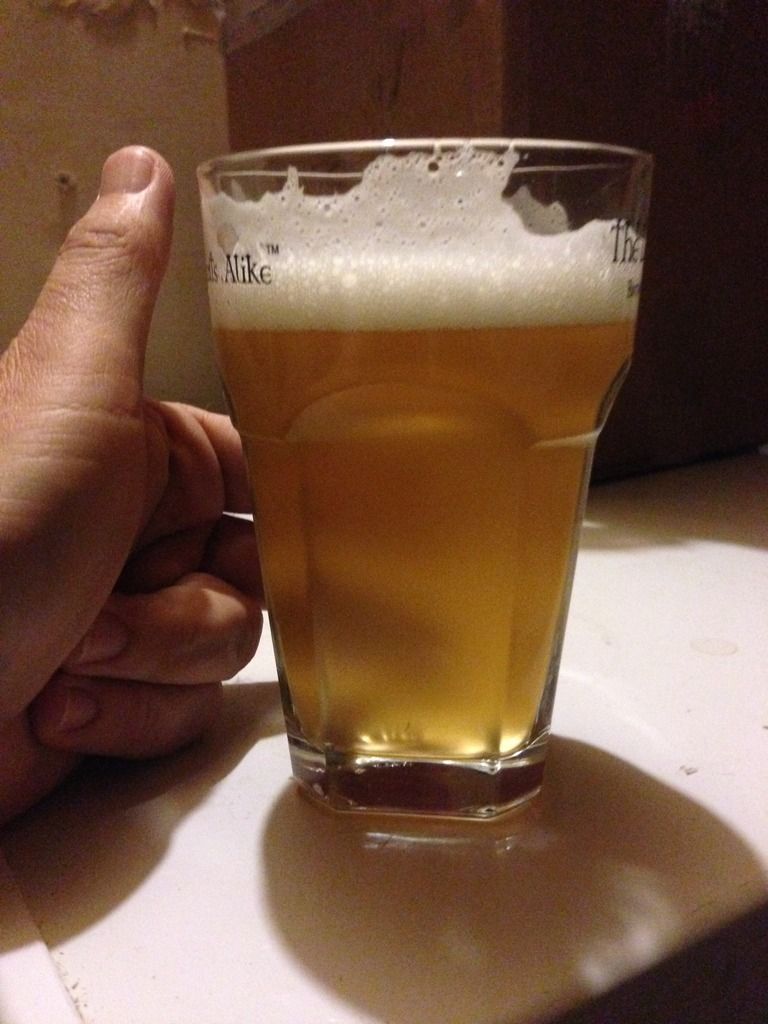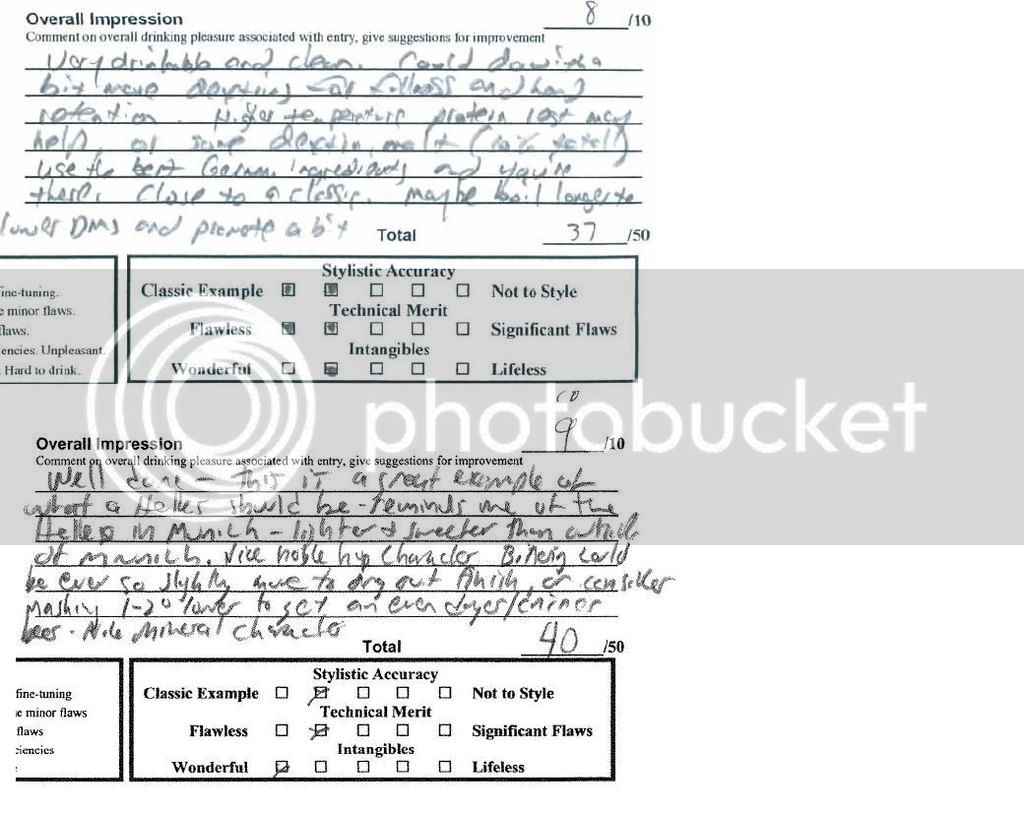- Recipe Type
- All Grain
- Yeast
- WLP833
- Yeast Starter
- Yes. Lager Pitch Rate
- Additional Yeast or Yeast Starter
- No
- Batch Size (Gallons)
- 5.5
- Original Gravity
- 1.048
- Final Gravity
- 1.009
- Boiling Time (Minutes)
- 90
- IBU
- ~20
- Color
- 4.6
- Primary Fermentation (# of Days & Temp)
- 2 weeks. Pitched at 48F. Fermented at 50F till 1-2°Plato above FG. Passive ramp to 67F
- Secondary Fermentation (# of Days & Temp)
- N/A
- Additional Fermentation
- Cold-crashed, gelatin in FV. Lagering in Keg.
- Tasting Notes
- Judge\\'s Quote:
I spent a wonderful summer in Munich in the 90's, living in a 1 bedroom apartment with 7 friends. We lived just up the road from the Löwenbräu Keller. I developed quite a liking for this great style of beer. If memory serves  , this version is not too dissimilar to all those steins of beer my mates and I enjoyed during that great summer.
, this version is not too dissimilar to all those steins of beer my mates and I enjoyed during that great summer.

This recipe has it's roots in Brulosopher's Munich Helles. I figured after changing the grain-bill, yeast used, mash profile and fermentation schedule I could justifiably call it my own so am posting it here. There's not a whole lot to recipe for a Helles. It is a very simple and flavorful beer with the malt taking center-stage.
Grain-Bill (80% Brewhouse Efficiency)

NB: The acid malt is needed in my setup as I utilize full-volume mashes. No sparging. Thinner mashes may need some form of additional acid. I use acidulated malt for this reason in calculated amounts and subtract them from the originally planned base malt to keep the OG unchanged. If acid malt is not needed in your setup simply delete it and substitute it with Pilsner malt.
Hops

Yeast
A starter size based on the date of the yeast vial and a lager pitch-rate with my usual method. The starter is decanted prior to pitching the yeast.
Water

Mash profile

A full-volume, no-sparge step-mash via direct heating of the mash-tun was carried out with my usual BIAB method.
Mash pH was 5.29
Another option would be a single infusion at 150F.
Gravity prior to ramping the temperature and the beer's final gravity (FG)

Fermentation Profile

NB: Despite the titles which I use to enable me to enter the differing temperatures with ease in Beersmith, all fermentation is done in the primary. No racking other than to the keg after cold crashing and gelatin fining. The stated times in the profile are approximate only. Changes to the temperature are dictated by visual clues and measuring the gravity.
This beer was kegged 2 weeks after pitching the yeast. The beer was lagered at ~35F for about four weeks while carbonating and was very good at this point. Force-carbonated to ~2.7 volumes. 6 weeks after pitching yeast it is good but this beer had an additional 2 weeks of lagering in the keg prior to me bottling some for competition. (8 weeks total).
Judge's Feedback.

Judges Feedback: Excellent Beer! Clean with nice malt character and well balanced hops
This beer is marvelous IMHO, and was my first lager. It recently scored an average of 43.5 in The Limbo Challenge in the light lager category, losing out to two other great beers including the winner of "Best in Show". This was my first competition. I'm obviously very happy with the positive feedback.
This beer has big fat foamy white head that persists. It is crystal clear with a great malty flavor and low hop bitterness. It is an extremely clean tasting beer with a nice grainy pilsner character. Very refreshing and delicious!
Gelatin

Helles Yeah!


I will be also be entering it in the upcoming Octoberfest competition here in north Texas. I'll post the judges feedback when I get it. I have high hopes for a good result.
If you brew it, let me know what you think. Prost!
 , this version is not too dissimilar to all those steins of beer my mates and I enjoyed during that great summer.
, this version is not too dissimilar to all those steins of beer my mates and I enjoyed during that great summer.
This recipe has it's roots in Brulosopher's Munich Helles. I figured after changing the grain-bill, yeast used, mash profile and fermentation schedule I could justifiably call it my own so am posting it here. There's not a whole lot to recipe for a Helles. It is a very simple and flavorful beer with the malt taking center-stage.
Grain-Bill (80% Brewhouse Efficiency)
NB: The acid malt is needed in my setup as I utilize full-volume mashes. No sparging. Thinner mashes may need some form of additional acid. I use acidulated malt for this reason in calculated amounts and subtract them from the originally planned base malt to keep the OG unchanged. If acid malt is not needed in your setup simply delete it and substitute it with Pilsner malt.
Hops
Yeast
A starter size based on the date of the yeast vial and a lager pitch-rate with my usual method. The starter is decanted prior to pitching the yeast.
Water
Mash profile

A full-volume, no-sparge step-mash via direct heating of the mash-tun was carried out with my usual BIAB method.
Mash pH was 5.29
Another option would be a single infusion at 150F.
Gravity prior to ramping the temperature and the beer's final gravity (FG)

Fermentation Profile

NB: Despite the titles which I use to enable me to enter the differing temperatures with ease in Beersmith, all fermentation is done in the primary. No racking other than to the keg after cold crashing and gelatin fining. The stated times in the profile are approximate only. Changes to the temperature are dictated by visual clues and measuring the gravity.
This beer was kegged 2 weeks after pitching the yeast. The beer was lagered at ~35F for about four weeks while carbonating and was very good at this point. Force-carbonated to ~2.7 volumes. 6 weeks after pitching yeast it is good but this beer had an additional 2 weeks of lagering in the keg prior to me bottling some for competition. (8 weeks total).
Judge's Feedback.

Judges Feedback: Excellent Beer! Clean with nice malt character and well balanced hops
This beer is marvelous IMHO, and was my first lager. It recently scored an average of 43.5 in The Limbo Challenge in the light lager category, losing out to two other great beers including the winner of "Best in Show". This was my first competition. I'm obviously very happy with the positive feedback.
This beer has big fat foamy white head that persists. It is crystal clear with a great malty flavor and low hop bitterness. It is an extremely clean tasting beer with a nice grainy pilsner character. Very refreshing and delicious!
Gelatin

Helles Yeah!


I will be also be entering it in the upcoming Octoberfest competition here in north Texas. I'll post the judges feedback when I get it. I have high hopes for a good result.
If you brew it, let me know what you think. Prost!







